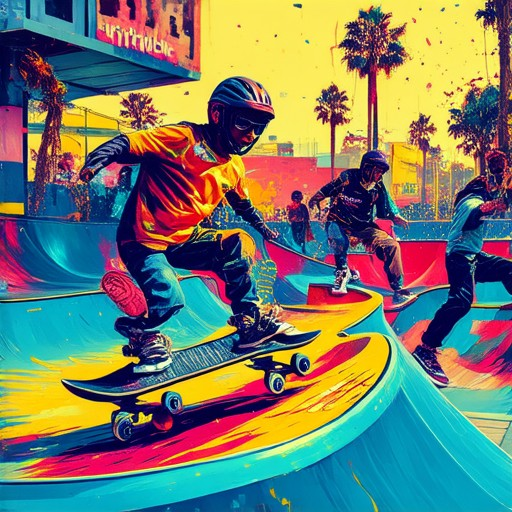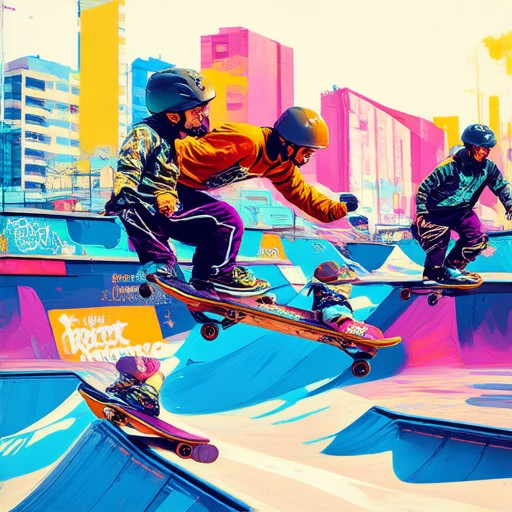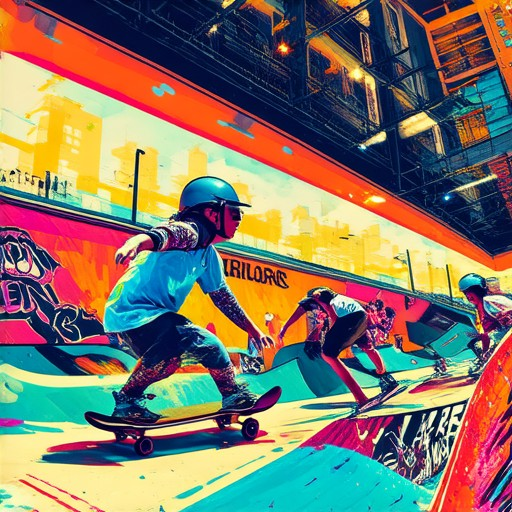Skateboarding is a thrilling and dynamic sport that offers endless opportunities for creativity and progression. Whether you’re a seasoned pro or just starting out, finding the perfect place to practice and perfect your skills is crucial. Skateparks are a fantastic option for many skateboarders, offering a controlled environment with dedicated features designed for riding. However, it’s equally important to consider the differences between skateparks and street riding, as each has unique advantages and challenges. In this guide, we’ll explore everything you need to know about skateboarding at skateparks, including tips for enjoying public spaces responsibly, essential gear requirements, and how to navigate common rules and regulations. From discovering top spots in California and Florida to understanding why some parks enforce strict bans, this article will provide you with all the information you need to make informed decisions about where and how to ride. Let’s dive in and uncover the ins and outs of skateboarding at skateparks!
Key Takeaways
– Promotes Physical Activity: Skateboarding boosts cardiovascular health and overall fitness, making it a great activity for public spaces.
– Engages Youth Constructively: It provides a positive outlet for youth, fostering creativity, teamwork, and socialization.
– Encourages Community Interaction: Skateboarding fosters a sense of belonging and vibrancy in public areas.
– Economic Boost: Designated skate areas attract tourists and support local businesses through events and foot traffic.
– Reduces Crime and Vandalism: Properly managed skate areas can decrease graffiti and improve safety.
– Adds Cultural Richness: Skateboarding’s global popularity makes it a cultural asset, attracting visitors and preserving its heritage.
– Respect Local Laws: Always check for regulations and avoid restricted areas like roads, school zones, and private properties.
– Protect Park Infrastructure: Parks may ban skateboards to preserve surfaces and maintain safety, but many invest in skateparks for responsible skating.
– Minimize Noise and Disturbance: Skateboarding can create noise, so consider dedicated areas to balance activity with tranquility.
– Invest in Skateparks: Creating skateparks manages environmental impact and ensures safe, sustainable locations for skating.

Where Can I Practice Skateboarding?
Skateboarding can be practiced in various safe and suitable locations. Here are some recommended spots:
- Skate Parks: These are specifically designed for skateboarding, offering smooth surfaces and features like ramps and rails.
- Empty Parking Lots: Look for ones that are flat and free from obstacles, but always check local regulations first.
- Driveways: Some driveways can be used if smooth and free of debris, but ensure you have permission from the property owner.
- Indoor Facilities: Many cities have indoor skateparks that offer a controlled environment, ideal for learning and practicing tricks.
- Community Centers: Some centers may have skateboarding sessions or equipment rentals available.
- School Campuses: Check with the school administration to see if there are permitted areas for practice.
- City Recreational Areas: Look for designated skate zones in local parks or sports complexes.
For more localized information, consider reaching out to local skaters, visiting skate shops, or joining online forums and social media groups focused on skateboarding in your area.
Is Street or Park Skateboarding Better?
To determine whether street or park skateboarding is better, consider these key factors:
| Street Skateboarding | Park Skateboarding |
|---|---|
| Space and Freedom: Requires less space and can be done almost anywhere. | Space and Freedom: Needs a designated skate park with specific facilities. |
| Obstacles: Utilizes public structures and surfaces for creative tricks. | Obstacles: Features purpose-built ramps, rails, and features designed for skateboarding. |
| Skill Level Required: Suitable for all skill levels as long as there are safe spaces. | Skill Level Required: Ideal for intermediate to advanced skateboarders due to higher obstacles and potential hazards. |
| Location Availability: Can be done in urban areas, parks, or parking lots. | Location Availability: Limited to skate parks or specific designated areas. |
| Creativity and Spontaneity: Offers more variety with real-world objects and surfaces. | Creativity and Spontaneity: Provides structured opportunities for consistent trick progression. |
Choose street skateboarding if you prefer spontaneity and exploring various environments. Opt for park skateboarding if you want a controlled setting with more advanced features. Both offer unique experiences and can be enjoyed by skateboarders of all levels, depending on your preferences and skill comfort.
For more information on skateboarding equipment and techniques, visit our resource hub .

Disadvantages of Skateparks
Skateparks offer a fun and vibrant space for skateboarders, BMX riders, and rollerbladers to enjoy their hobbies. However, like any public facility, they come with their own set of challenges and drawbacks. Here are some of the key disadvantages:
- Safety Concerns: Crowded parks can lead to increased risks of accidents, falls, or collisions between different types of vehicles. Lack of awareness among users can exacerbate these dangers.
- High Maintenance Costs: Constructing and maintaining skateparks requires significant investment in equipment and infrastructure. Wear and tear, along with potential damage from weather conditions, necessitate regular repairs and updates.
- Environmental Impact: The concrete surfaces used in skateparks can contribute to heat islands, affecting nearby vegetation. Additionally, they can accumulate grime and litter, leading to environmental degradation.
- Noise Pollution: The constant activity at skateparks generates significant noise, which can disturb nearby residents and harm community relations.
- Crowd Control Issues: Busy periods can lead to long wait times and frustration among users. Managing rule enforcement and ensuring safe behavior becomes a challenge without adequate staffing or signage.
- Perception and NIMBYism: Some communities may view skateparks as eyesores or associated with urban decay, potentially leading to resistance from local residents or businesses and affecting property values.

Why Skateboarding Should Be Allowed in Public Places?
Skateboarding offers numerous benefits that make it a valuable activity to permit in public spaces. Below are key reasons why skateboarding should be allowed in public places:
1. Promotes Physical Activity
Skateboarding is an excellent form of exercise that combines cardiovascular health, strength, and flexibility. It encourages individuals of all ages to engage in regular physical activity, contributing to overall fitness and well-being. By allowing skateboarding in public places, communities can foster a more active population, reducing obesity rates and associated health issues.
2. Engages Youth Constructively
For young people, skateboarding provides a positive outlet for energy and creativity. It helps youth develop motor skills, confidence, and a sense of accomplishment. Skate parks and public spaces designated for skateboarding can act as safe hubs where kids can socialize and learn teamwork, all while enjoying a fun activity.
3. Encourages Community Interaction
Skateboarding often brings people together. Skaters share a common passion for the sport and frequently collaborate or watch each other perform tricks. This shared interest fosters a sense of belonging and community spirit, making public spaces more vibrant and welcoming for everyone.
4. Economic Benefits
Public skateboarding spots can attract visitors to local areas, boosting tourism and supporting nearby businesses. Skate events, competitions, and festivals can draw large crowds, generating economic activity and increasing foot traffic in otherwise quiet neighborhoods.
5. Environmental Impact
Skateboarding can actually help improve public spaces. Skaters often take pride in maintaining their skate parks and surrounding areas, leading to better upkeep and increased appreciation for public infrastructure. This sense of responsibility can extend to broader community efforts to maintain public spaces.
6. Reduces Crime and Vandalism
Studies suggest that having designated skate areas can reduce graffiti and vandalism, as skaters often take ownership of their spaces and work to keep them clean and safe. This proactive behavior contributes positively to the overall safety and appearance of public spaces.
7. Cultural Richness
Skateboarding has a rich cultural history and a global following. Allowing skateboarding in public places preserves and celebrates this cultural heritage, making cities more interesting and diverse. It also attracts visitors who are interested in experiencing this unique sport firsthand.
Learn more about maintaining your skateboard equipment .
By embracing skateboarding in public places, communities can enjoy a range of benefits from improved health to stronger social bonds. It’s a simple yet impactful way to enhance the quality of life for residents and visitors alike.
Where Are You Not Allowed to Skateboard?
You must be cautious about certain areas where skateboarding is prohibited or restricted. Here are some key places where you are not allowed to skateboard:
- Roadways and Bike Lanes : Skateboarding on roads or in bike lanes is illegal in many areas. These areas are meant for cars and bicycles, and skating there can be dangerous and against local regulations.
- School Zones : Skateboarding in school zones is typically prohibited due to high pedestrian traffic and the presence of children.
- Parking Lots : Some parking lots may restrict skateboarding. Always check for signs or ask the property owner before skating.
- Private Properties : Without permission, skateboarding on private properties, such as people’s lawns or driveways, is considered trespassing.
- Shopping Centers and Malls : Many shopping centers have strict “no skateboarding” policies. Look for signs or contact management if unsure.
- Public Transportation Areas : Platforms, tracks, and stations owned by public transit authorities may prohibit skateboarding. Check for signs or inquire with staff.
- Residential Areas : Skating on residential streets or sidewalks without permission can lead to conflicts with residents. Always respect private property rights.
- Areas with “No Skateboarding” Signs : Any location with visible signage indicating skateboarding is prohibited should be avoided.
Always respect local laws and regulations, and be mindful of the surroundings when choosing where to skate. Checking for permits or permissions is essential, especially on private or restricted areas.

Why Do Parks Ban Skateboards?
Parks often prohibit skateboarding due to several reasons, including safety concerns, potential damage to park infrastructure, and the need to maintain a peaceful environment for all visitors. Here are the primary reasons:
- Damage to Park Infrastructure : Skateboarding can cause significant wear and tear on surfaces like grass, pavement, and concrete. Regular parks may not be designed to withstand the stress caused by skating, leading to quicker deterioration of these areas.
- Safety Concerns : The quick and dynamic nature of skateboarding poses risks of accidents, injuries, or property damage. Public parks are intended to be accessible and safe for all individuals, including families and children, making it necessary to restrict activities that could lead to harm.
- Noise Pollution : Skateboarding generates noise through wheel clicks and grinds, which can disrupt the tranquility of the park environment, particularly for those seeking a quiet or peaceful experience.
- Regulatory Restrictions : Many parks adhere to local ordinances or regulations that prohibit certain activities, such as rollerblading or biking, on specific surfaces. Skateboarding may fall under these restrictions due to its similarity to other wheeled vehicles.
- Lack of Dedicated Facilities : Parks without designated skateparks may feel the need to restrict skateboarding to prevent unsafe conditions and to encourage the use of properly built facilities that can handle the activity safely.
- Environmental Impact : Skateboarding on grass can compact the soil, affecting plant growth and drainage. This environmental impact is easier to manage in dedicated skateparks designed for such activities.
By addressing these factors, parks aim to preserve their infrastructure, ensure visitor safety, and maintain a serene atmosphere for everyone. However, many cities invest in constructing skateparks to provide a safe and appropriate space for this popular activity.
Conclusion: Parks ban skateboards primarily to protect their infrastructure, ensure public safety, minimize noise disturbances, and uphold regulatory standards. While this may seem restrictive, it helps maintain the integrity and usability of these shared spaces for all users.




0 Comments